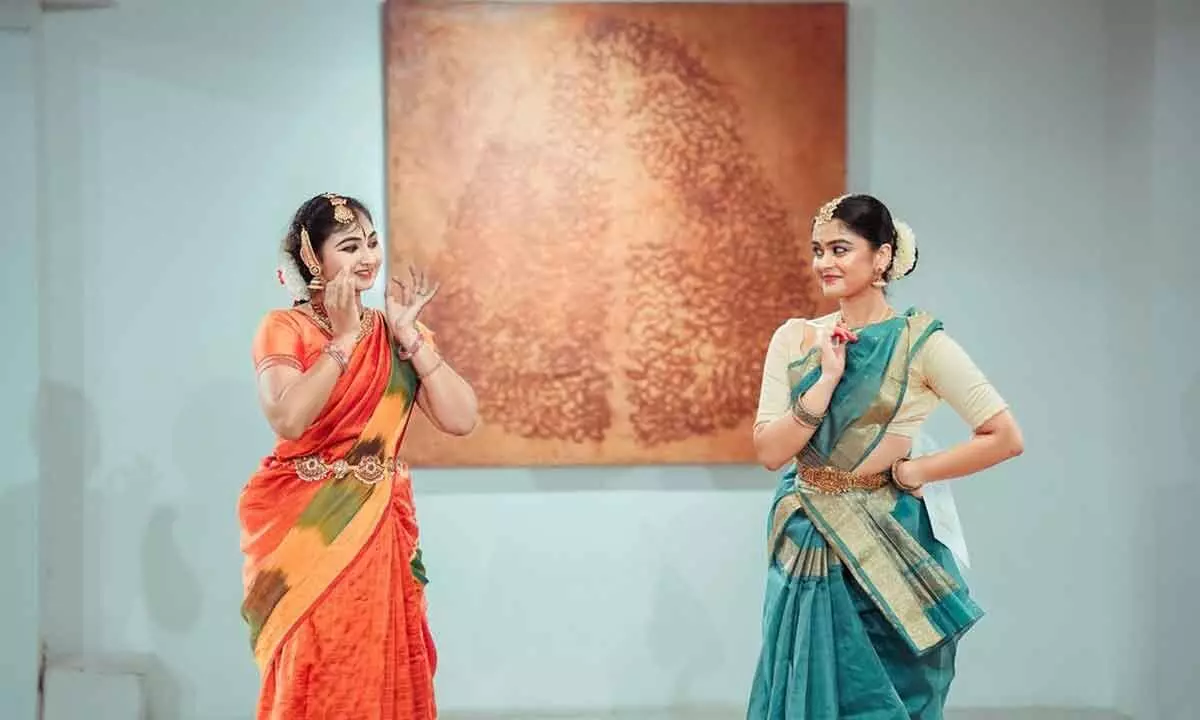Live
- They always want me to win, and now I feel lucky to have been offered a story like ‘Zebra’: Satyadev Kancharana
- ‘Democracy first, humanity first’: PM Modi in Guyana's parliament on two countries' similarities
- PKL Season 11: Telugu Titans register third straight win to top standings
- Is Pollution Contributing to Your COPD?
- NASA Unveils Underwater Robots for Exploring Jupiter's Moons
- Additional Central forces arrive in violence-hit Manipur
- AR Rahman and Saira Banu’s Divorce: Legal Insights into Common Issues in Bollywood Marriages
- 82.7 pc work completed in HPCL Rajasthan Refinery area: official
- Curfew relaxation extended in 5 Manipur districts on Friday
- Tab scam prompts Bengal govt to adopt caution over fund disbursement
Just In
Kuchipudi Extravaganza Captivates Art Lovers


Vyshnavi Korlakunta and Medha Srigiri captivated the audience with their enchanting Kuchipudi performances at Dhi Art Studio. Their graceful and expressive dancing left a lasting impression on all who attended
Dhi Art Studio at their gallery in Ameerpet, an interactive space for diverse artistic engagements, arranged an evening Kuchipudi recital on the weekend. The intimate space hosting the presentation with paintings and other art as a backdrop was a delightful experience for the viewers. Vyshnavi Korlakunta and Medha Srigiri, young and talented artistes, engaged the audience’s rapt interest in a series of pieces titled “Kuchipudi Carousel.” The idea was to bring conversations of art to the common public. The program was directed by Bhargavi Gundala and curated by Srilagna.
Kuchipudi, which started out as a dance drama theatre form, has evolved into a solo performing art to meet the wants and needs of the times, patrons, and spectators. Vyshnavi demonstrated pieces from the dance drama repertoire, reflecting her focused training in that area, while Medha, having learned Dr. Vempati Chinna Satyam’s style of Kuchipudi, performed items suitable for solos. The aharya was not the usual elaborate attire but lighter material of amber orange interspersed with green and gold, and sky blue with a silver border respectively, which suited the informal ambiance. Jewellery was also suitably toned down to match. Though less than is the norm, it sparkled and coruscated with exceptional beauty due to the care taken in choosing the pieces.
To begin with, as Medha danced with elan, Vyshnavi recited the Naandi Stuti. These verses from the Natya Sastra are part of the traditional Poorvaranga Vidhi or pre-performance ritual. The meaning contained in the verses is as follows: “Let the country, rulers, and scholars prosper, patrons of art and artistes flourish, may the audience and all the people involved in art attain enlightenment.”
Keertanas were added comparatively later in Kuchipudi, but the first item by Medha was a Purandara Dasa Keertana, “Gajavadhana Beduve” in Hamsadhwani, as an invocatory piece. Medha effortlessly went through the piece as it describes Ganesha with suitable angika and hasthabhinaya. Her energy took her across the small stage with a gliding pace. The choreography was appreciated as in such compositions the interpretation depends on the imagination of the individual artiste. Ganapati is beseeched to act as a means for the Saint Composer to reach Lord Panduranga.
A treat which came next were the excerpts from Bhama Kalapam, which occupies a position of pride in the line of Bhagavatha families who have performed it for centuries. The principal characters are Lord Krishna, Satyabhama, and Madhavi. Vyshnavi as Satyabhama inquires as to Krishna’s whereabouts after he left her abode a short while ago. However, when her confidante Madhavi, played by Medha, mischievously tries to make Satyabhama name her lord by refusing to recognize the various descriptions she gives of her husband, Satyabhama is all bashful confusion. The novel element of incorporating English for the dialogue by Madhavi was intriguing.
Set to Raaga Mohanam, Ramayana Shabdam, a hymn in praise of Lord Rama, tells the story of the Ramayana. Ending with pure nritta, a notable section was the “Konagulu” or linking of toes together by the dancer as she dances, which was skillfully done. The audience was able to give this highlight the attention it deserved as Medha had mentioned that it would occur during the course of the item.
The Padam “Atthavarooriki Amperu Mavaaru” was winsomely done by Vyshnavi. Attributed to Kshetrayya, it describes the anguish of a teenage girl who is being sent to her in-laws’ place. She bids farewell to Krishna, for whom she has developed affection, meanwhile expressing that she will endeavor to come back to him despite it being a betrayal of her relatives and warns Krishna not to transfer his love to others. This was done in a sitting posture as it consisted predominantly of abhinaya to show the development of the story. Vyshnavi was able to convey the hesitant and poignant mood of the heroine very expressively and aptly.
Medha depicted that portion of the Tarangam “Govardhanagiridara” which involves dancing while balancing on the rim of a brass plate. Her dexterity was remarkable as she managed the difficult feat of moving the plate in patterns to the rhythmic jathis.
Swami Dayananda Saraswati is the author of “Bho Sambho.” Vyshnavi was radiant as she went through the descriptions of the formless Tatva to the Tandava Priya qualities of Shiva. The Gangavataranam scene was amazing. The episode of Ravana’s pride being crushed when he tries to lift Mount Kailasa and his humble praise of Shiva by using his entrails as Veena Strings was dramatically done as the concluding piece.
Dr. Yashoda Thakore, Faculty of Silicon Andhra University, was present. The audience rendered enthusiastic applause and conversed with the artistes for a brief interactive session.

© 2024 Hyderabad Media House Limited/The Hans India. All rights reserved. Powered by hocalwire.com






